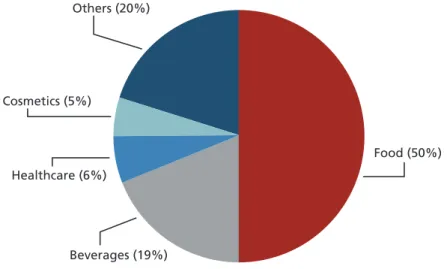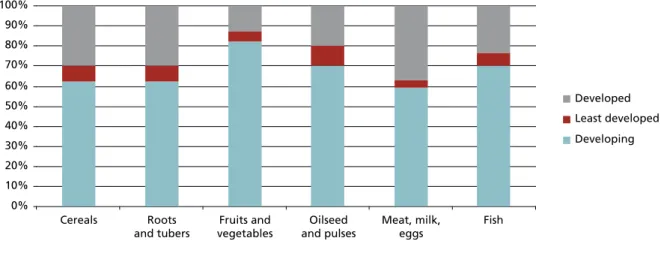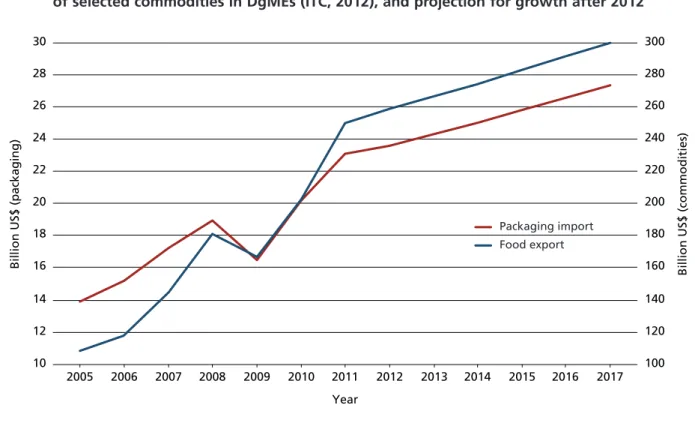Of the three sub-sectors of the packaging industry (manufacturing, machinery and service), there appears to be the greatest potential to develop package manufacturing in developing countries, given the tendency to process closer to the source of production and the availability of paper and cardboard packaging materials. A comprehensive analysis of the true value of packaging and the options available (usually a factor of demand for commodities requiring packaging, resource availability and innovation capabilities, among others) can put the cost of packaging into perspective. An overview is then provided of the status and trends of food packaging in developing countries, and a SWOT (strengths-weaknesses-opportunities-threats) analysis is performed.
In terms of end product type, packaging production has the largest share of the total industry worldwide (81%), followed by packaging service (14%), and then by packaging machinery (5%). The packaging production sub-sector is not so much globalized, with exports accounting for only a quarter of the total market volume. It is important to note that this sub-sector does not include the manufacture of the packaging or label itself.
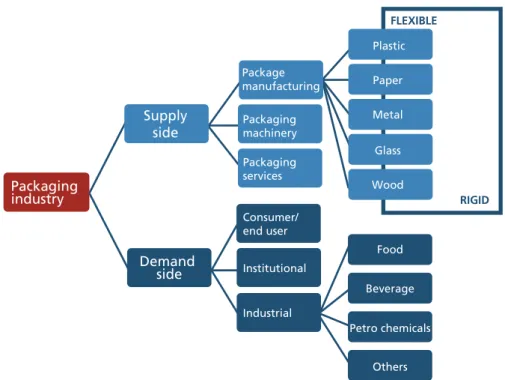
Supply Side – by form and type of packaging material
This is attributed to its general tendency to set up operations closer to its end market to reduce variable costs. The sub-sector also consists largely of small and medium enterprises (SMEs) with a large number falling under the classification of less than 10 employees, especially for the manufacture of wooden packaging. The packaging service subsector consists of businesses primarily involved in the packaging and labeling of customer-owned materials (such as food products) which are usually undertaken on a contract or outsourcing basis.
Food packaging in developing countries – status and trends
- VOluMES OF TRADE
- MEETINg ThE NEEDS OF COMMODITy ChAINS
- REgIONAl DIMENSIONS OF gROwTh
- ThE STATE OF REgIONAl DEVElOPMENT
- INVESTMENT OPPORTuNITIES IN DEVElOPINg COuNTRIES
Meal preparation takes time, and with the advent of dual-income households, where women are also busy with activities outside the home or men are expected to participate in food preparation, food that comes in easy-to-open packages and close again, extremely popular . Many factors contribute to the growth of the packaging industry and vary by region. In the case of Asia, for example, the largest contributors are the fast-growing economies of China and India, which are driving increasing demand for food supplies and, in turn, demand for packaging in the region.
In Africa, proximity and access to the lucrative US and European markets is driving the growth of the packaging industry. This is further aided by international trade policies that favor the export of Middle Eastern products to developed countries, which then translates into increased demand for packaging products and technologies. For Latin America, the drivers of its development program and domestic policies are shaping the growth of the packaging industry, such as market deregulation and free trade agreements.
The state of the packaging industry varies within and between regions, as its growth depends on regional economic development and the production and market potentials of key commodities. The state of the packaging industry (based on selected sample countries) is presented in Table 2, highlighting regional differences in strengths, weaknesses, opportunities and threats (SWOT) as derived from the status and development of the respective food industry. The projection on the potential size and investment opportunities in the packaging needs of emerging market economies (DgMEs) is based on (1) the growth of imports of packaging materials and (2) the growth of exports of food commodities for the period 2005 – 2012.
An aggregate of the imports of packaging materials and of the exports of selected commodities is shown in Figure 5. Regarding the commodity exports, the global trend is expected to increase continuously until 2017 with a growth rate of around 3%.
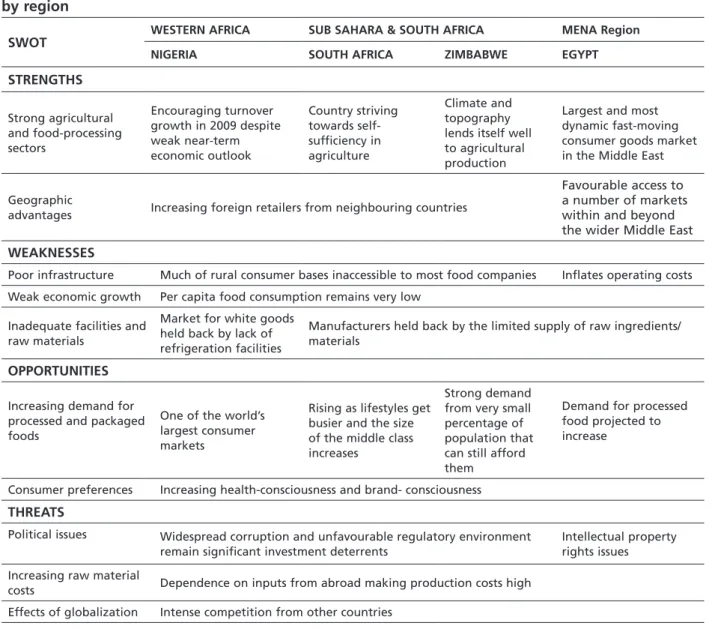
Food packaging solutions in developing countries
- ADDRESSINg FOOD lOSSES IN ThE VAluE ChAINS
- TRADE wITh INDuSTRIAlIZED REgIONS
- PRODuCT AND TEChNOlOgy DEVElOPMENT
- COMPETITIVENESS OF SMAll AND MEDIuM ENTERPRISES (SMES)
- Pre-Packing and contract Packing
- recycling of Packaging material
- Packaging machinery
Senior Scientist Postharvest Development The International Rice Research Institute photographs are part of the International Rice Research Institute Image Collection (www.irri.org). While the trade performance of the DgME packaging industry is on par with that of the DME, the packaging industry in these regions is not without its challenges. Industry constraints plague the packaging sector in almost all regions, such as limited packaging solutions to meet the demands of the international market and low domestic demand for packaging materials, which in turn leads to low investment by the packaging industry.
A double investment scenario has been observed, and both have a restraining effect on the growth of the packaging sector. First, very little investment has so far been made in the development of traditional technologies or in the application of scientific knowledge in most developing countries. If not handled properly in the beginning, this can have a negative impact on the economic viability of the company and the packaging company that diverts its business from it will also be affected.
However, these costs are offset by the savings opportunities and frequency of reuse over the extended useful life of the packaging (Box 2). An interesting aspect of the increasing need to supply prepackaged products to export markets is the possible application of contract packaging. An example for the Philippines is the Packaging Research and Development Center of the Department of Science and Technology (DOST) - Industrial Technology and Development Institute (ITDI), which assists SMEs in accessing packaging technologies through technology transfer and purchase facilitation, among other things. .
Risk-benefit analysis should include both the safety level of the material and the adverse effects of a limited supply (Marsh, 2001). Many traders in General Santos, the tuna capital of the Philippines, prefer to export sashimi-grade tuna in a refrigerated location instead of frozen.
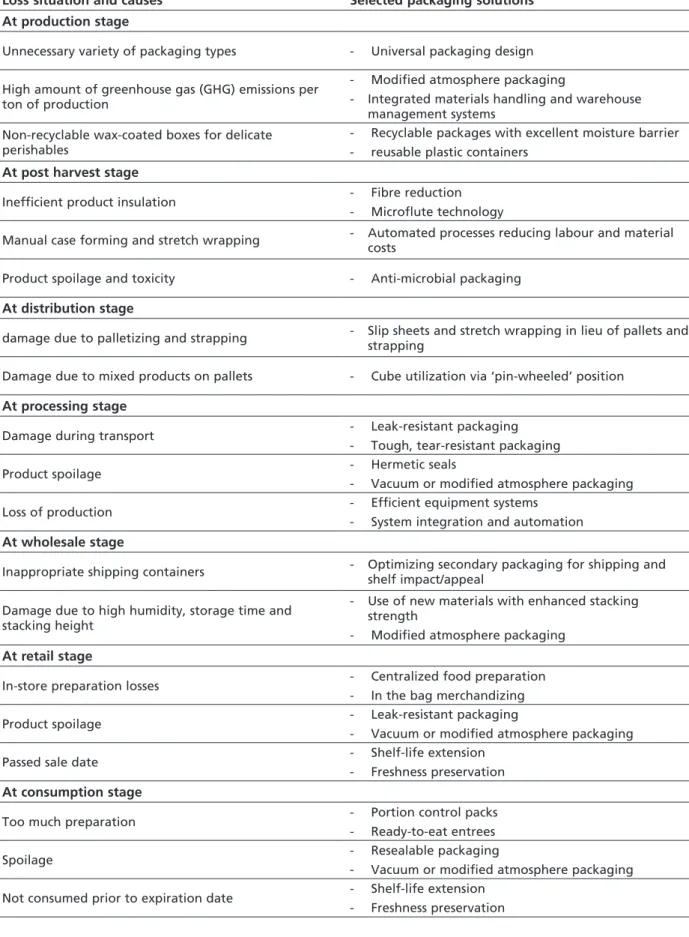
A Fish Port with Packing & Packaging Facility Boosted Tuna Industry
CREATIVITy, INNOVATIONS AND INITIATIVES
Competition in the global consumer olive oil market is very fierce and is monopolized by traditional producer countries such as Italy and Spain, and there is very little room for newcomers, unless it is in bulk, where the oil will be bottled under well-known brands from traditional producers. Egypt emerged as an olive oil exporting country only in the mid-nineties, and the small export volumes were mostly in bulk. Thanks to this innovative packaging style, consumers in export markets were attracted to buy from a new non-traditional manufacturer with a poor track record in the market.
Note that the picture on the package has nothing to do with olive oil. Repositioning local potatoes as a tasty and healthy food through branding enabled by the right packaging. It is a source of the country's traditional heritage and promotes biodiversity with around 3,500 varieties of native potatoes cultivated in the Andean highlands of Peru.
Culinary importance of native potatoes in the gastronomic wave of Peru promoting cultural and national identity. Reinventing the image of native potatoes into a gourmet, naturally healthier product with links to Peru's cultural heritage. It also ranks as the most recyclable packaging material in the world today (SMC website).
The main processing plant is located in San Fernando, Pampanga in Luzon, with conversion operations on the three major islands of Luzon, Visayas and Mindanao. SMC's PET recycling plant, the first of its kind in Asia, opened doors to community opportunities through direct employment and contract services.
Concluding statements
24 Appropriate food packaging solutions for developing countries. especially fruits and vegetables) from developing southern economies to their northern and western markets will need to be extended to their packaging. Standardization of containers is becoming a cost-cutting strategy, which has resulted in a wider range of package sizes to accommodate the diverse needs of wholesalers, consumers, food service buyers, and processors. Of the three packaging sub-sectors, there is greater potential in packaging manufacturing than in packaging machinery or packaging services for developing countries.
This is in light of the fact that the packaging machinery sub-sector is heavily dominated by developed countries. It is worth looking at the potential of the used machinery market in the short and medium term. However, in the long run, it will work better for developed countries to look at the potentials of simple locally fabricated packaging machines that are suitable for their specific needs and requirements.
The development of the packaging service delivery sub-sector, particularly in relation to pre-packaging and outsourcing, will provide the necessary boost to food packaging in developing countries. Since packaging materials are in short supply in developing countries, easing packaging regulations without compromising food safety is sure to help the industry. An example is allowing the use of recycled packaging materials where they do not pose a contamination problem (eg dry foods).
Such a relaxation of packaging standards will help to provide a wider range of packaging materials, while also eliminating concerns about food loss.
Retrieved September 14, 2010, from Euromonitor Global Market Monitor Blog: http://blog.euromonitor.com/. Costs, profits and productivity of the food industry. The global market for packaging machines will exceed 40 billion US dollars, companyandmarkets.com,. http://www.companiesandmarkets.com/news/global-market-for-packaging-machinery-to-exceed-us-40-billion-n115.aspx). Retrieved September 15, 2010, http://www.packagingtoday.co.uk http://www.packagingtoday.co.uk/story.asp?storyCode=60110.
Retrieved September 15, 2010, from http://www.packagingtoday.co.uk/story.asp?storyCode=60285§ioncode=41 Packaging Trend: The Future Outlook. Familiarity with sustainable packaging. http://www.proinvest-eu.org/event/africa-food-pack-dakar-march-2010. September 16, 2010, from http://www.foodproductiondaily.com/Packaging/Crown-to-expand-capacity-to-meet-rising-Brazilian-demand.
Integracore-Turn-key, Supply Chain Outsourcing, Worldwide Fulfillment and Inventory Management. http://articles.directorym.com/Packaging_Supply_. Reducing food losses Important part of food security. http://www.southern states. com/sscinfo/news/2009/1009_foodlossfoodsecurity.aspx. Rapid Response Assessments: Environmental Food Crisis (World Food Supply - Animal Feed) http://www.grida.no/publications/rr/food-crisis/page/3565.aspx.
Driving Sustainable Consumption: Value Chain Waste (Overview) http://www.weforum.org/pdf/sustainableconsumption/DSC%20Overview%20Briefing%20-%20 Value%20Chain%20Waste.pdf. Position Paper-Market Trends and Development.. http://www.worldpackaging.org WEB REFERENCES . http://cms.bnpmedia.com/uploaded/DF%5CImproving%20Sustainability%20through%20Packaging.pdf http://www.agfa.com/en/gs/solutions/package_printing/index.jsp).
